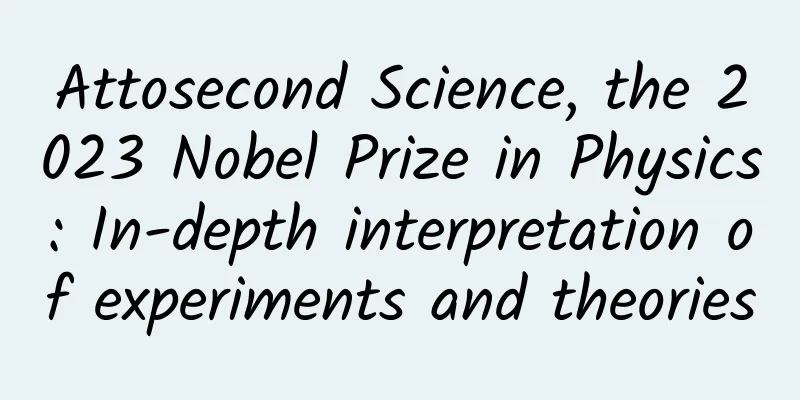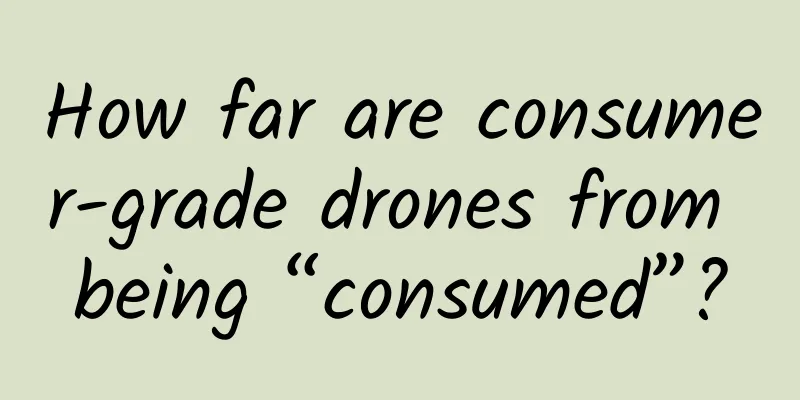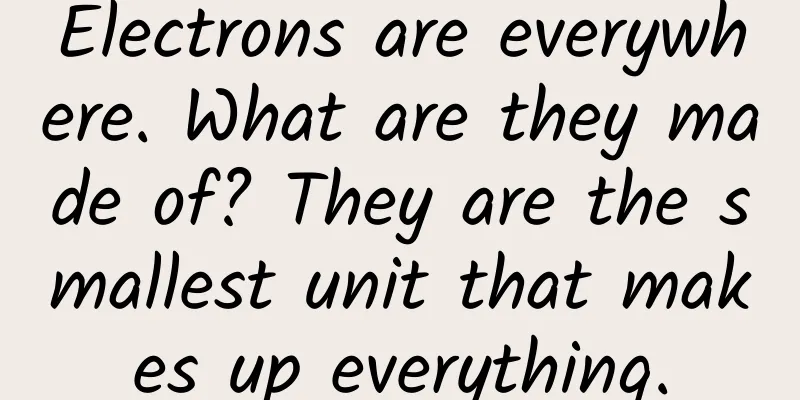Attosecond Science, the 2023 Nobel Prize in Physics: In-depth interpretation of experiments and theories

|
This year's Nobel Prize in Physics was awarded to attosecond science, which has drawn public attention to the word "attosecond". Attosecond optical technology has opened a window, making it possible to detect electron dynamics in atoms. Attosecond science is currently one of the most cutting-edge scientific research fields in ultrafast optics. This article will briefly review the development of attosecond science, introduce milestone scientific research and related scientists, interpret some important experimental techniques and theoretical methods in attosecond science and ultrafast optics, and analyze the meaning of related physical terms. Written by | Shaohao Chen (Massachusetts Institute of Technology) How fast is an attosecond? Attosecond science starts with what an attosecond is. Attosecond is a unit of time, equal to 10^(-18) seconds. Written as a decimal, it is 0.0000000000000000001 seconds, with 17 zeros after the decimal point. This is a very, very, very short time. The age of the universe is about 10^18 seconds, which means that 1 attosecond is to 1 second as 1 second is to the age of the entire universe. A unit of time a thousand times larger than an attosecond is a femtosecond (10^(-15) seconds), and so on, and so forth ... To detect or photograph a moving process, the time sensitivity of the tool used must be much smaller than the time scale of the movement itself. Let's take an example from everyday life, such as photographing a fast-moving football. If you use a normal camera to take a photo, the position of the ball changes during the camera exposure time, so the photo taken is the result of overlapping images of multiple positions, so it is blurry. If you use a high-speed camera, the exposure time is very short, and the ball hardly moves during the exposure time, so that a clear photo can be taken. By controlling the shutter with electronic devices, the time sensitivity of the high-speed camera reaches the microsecond level, so that the movement of the bullet can be captured. Figure 1. Photo of a bullet passing through an apple taken with a high-speed camera | Source: webmuseum.mit.edu However, the time scale of microscopic particle movement is less than 1 nanosecond. For example, the period of molecular rotation is about picoseconds, and the period of molecular vibration is about hundreds to tens of femtoseconds. The movement of electrons in atoms is even faster, at the attosecond level. Taking the simplest hydrogen atom as an example, the energy of the ground state electron is one atomic unit. According to the uncertainty principle of quantum mechanics, the time scale of its movement is about 24 attoseconds. The time resolution limit of electronic devices is only tens of picoseconds. To obtain a resolution below one picosecond, only optical methods can be used. Femtosecond laser pulses (Femtosecond Laser Pulses) achieved by ultrafast optical technology can be used to detect the movement of molecules. Attosecond pulses of light (Attosecond Pulses of Light) based on femtosecond laser technology can be used to detect the movement of electrons in atoms. This is one of the reasons why the field of ultrafast optics is so important. Development of attosecond experimental technology Ultrafast optics is a branch of laser physics, which mainly studies the optical technology of generating light pulses with a time domain pulse width of less than 1 picosecond and its related applications. Laser is an abbreviation of Light amplification by stimulated emission of radiation, which means light amplification by stimulated emission. Stimulated emission refers to the phenomenon that atoms in an excited state emit photons under the action of external radiation. Its mechanism was first proposed by Einstein in 1917. Since its advent in 1960, lasers have been widely used in various fields of science and technology. With the development of laser technology, the time domain pulse width of laser pulses is getting shorter and shorter. With Ti-sapphire crystal as the gain medium, femtosecond laser pulses can be achieved by using mode locking technology. In the mid-1980s, French professor Gérard Mourou and his Canadian doctoral student Donna Strickland invented the chirped pulse amplification technology at the University of Rochester in the United States, and won the 2018 Nobel Prize in Physics for it. Chirped pulse amplification is one of the key technologies for achieving high-intensity femtosecond laser pulses. The word chirp originally means the sound of a bird. The pitch of a bird's call changes over time, that is, the vibration frequency of the sound wave changes over time. A chirped pulse refers to the electric field vibration frequency in a light pulse that changes over time. In the late 1980s, Ahmed Hassan Zewail, an Egyptian professor at the California Institute of Technology, used femtosecond laser technology to study chemical reaction processes, pioneering the field of femtosecond chemistry and winning the 1999 Nobel Prize in Chemistry. The intensity of femtosecond laser pulses is very high, reaching 1012-1014 watts per square centimeter. When the femtosecond laser is focused on a rare gas, the rare gas atoms absorb multiple photons, resulting in above-threshold ionization. Above-threshold ionization is named because there are multiple ionization peaks above the threshold. As early as 1979, Pierre Agostini, a scientist at the French CEA Institute, observed the above-threshold ionization phenomenon in an experiment for the first time. When the femtosecond laser is focused on a rare gas, another interesting phenomenon occurs - high harmonic generation. In 1987, Anne L'Huillier and her collaborators observed the high-harmonic phenomenon in an experiment for the first time, still at the French CEA Institute. (L'Huillier is currently a professor at Lund University in Sweden.) Femtosecond laser pulses generally contain multiple electric field vibration cycles, each of which is at least not shorter than 1 femtosecond, and the corresponding wavelength is in the infrared band. Therefore, if you want to obtain a light pulse with a time domain pulse width shorter than 1 femtosecond, you must use light with a shorter wavelength, that is, a larger photon energy. The photon energy of high-order harmonics is dozens or hundreds of times the energy of fundamental frequency photons, and the corresponding wavelength is in the extreme ultraviolet band. The electric field vibration period is much less than 1 femtosecond, so high-order harmonics have the necessary conditions to obtain pulses shorter than 1 femtosecond (i.e., attosecond pulses). Based on high-order harmonic generation and combined with phase matching technology, two experimental research groups independently achieved attosecond optical pulses in 2001. First, Pierre Agostini's research group developed the RABITT (Reconstruction of Attosecond Beating by Interference of Two-photon transitions) experimental technology, which for the first time achieved a series of equally spaced attosecond pulses, namely attosecond pulse trains, with a time domain pulse width of about 250 attoseconds for each pulse. (Agostini is now a professor emeritus at Ohio State University in the United States.) Shortly afterwards, the research group of Ferenc Krausz, a Hungarian professor at the Vienna University of Technology in Austria, developed the FROG-CRAB (Frequency-resolved optical gating for a complete reconstruction of attosecond bursts) experimental technology, which for the first time achieved a single 650-attosecond pulse. (Krausz is now the director of the Max Planck Institute for Quantum Optics in Germany.) Coincidentally, the abbreviations of the names of these two attosecond experimental technologies are exactly the English words rabbit, frog and crab. Another abbreviation for measuring attosecond pulses is SPIDER (Spectral phase interferometry for direct electric-field reconstruction), which is exactly the English word spider. Some industry insiders jokingly said that a "zoo" was built in the attosecond laboratory. Since then, several research groups have broken the record of attosecond pulse width in the time domain. The latest record is the light pulse with a pulse width of 43 attoseconds created by the research group of Professor Hans Wörner of the Swiss Federal Institute of Technology in Zurich (ETH) in 2017. Figure 2. Attosecond pulse train (solid black line) and electric field vibration of femtosecond laser (dashed red line). Each attosecond light pulse is separated by half an electric field vibration cycle, forming an attosecond pulse train. | Image source: After the birth of attosecond light pulses, many research groups used the pump-probe method to study the dynamics of electrons in atoms. This method uses femtosecond laser pulses and attosecond light pulses to act on inert gases together and control their time difference. For example, Ferenc Krausz's group first detected the Auger effect in the ionization process of inner shell electrons of krypton (Kr) atoms in the time domain. In addition to observing ionization products, another method is to observe the absorption spectrum of attosecond light pulses passing through gas atoms, which gave birth to a new subfield - attosecond transient absorption. Several research groups, including Stephen Leone's research group at the University of California, Berkeley, have made a series of achievements in attosecond transient absorption spectra. The application of attosecond light pulses is not limited to atoms in gases, but can also be used to study electron dynamics in solids. Several research groups, including David Reis's research group at Stanford University, have achieved a series of results in this regard. Ferenc Krausz's research group uses attosecond light pulses to detect biological molecules in human blood to carry out cancer research. Anne L'Huillier, Pierre Agostini and Ferenc Krausz shared the 2023 Nobel Prize in Physics for their groundbreaking contributions to high-order harmonics and attosecond light pulse experiments. As mentioned above, attosecond light pulses are generated through high-order harmonics, which is different from laser pulses formed by stimulated emission. In English literature, the term attosecond laser pulse is rarely used, and attosecond pulse or attosecond light pulse is more often used. According to Fourier transform, the smaller the pulse width in the time domain, the larger the pulse width in the frequency domain (i.e., energy domain). In the language of quantum mechanics, it is the uncertainty principle. A pulse with a time domain width of 100 attoseconds has a large pulse width in the frequency domain, reaching several electron volts (eV), so attosecond pulses are not monochromatic light and do not have the monochromaticity of lasers. In a small laboratory at the university, the desktop experimental device can only achieve very low-intensity attosecond light pulses, with an intensity of only about 106 watts per square centimeter, which is 6-7 orders of magnitude lower than femtosecond laser pulses. Initiated by Professor Mourou, the European Union has built the ELI (Extreme Light Infrastructure) Institute in recent years, which is currently the world's largest high-intensity laser facility and is expected to achieve the next generation of high-intensity attosecond light pulses. The pursuit of shorter time measurements continues, and the next goal is a light pulse of less than 1 attosecond, or zettasecond (10-21 seconds). The experimental group of Henry Kapteyn and Margaret Murnane at the JILA Institute at the University of Colorado, USA, in collaboration with the theoretical group of Andreas Becker, has produced higher-order harmonics with higher photon energy, reaching the X-ray band, and taking a step towards zettasecond pulses with shorter pulse widths in the time domain. Zettaseconds are the time scale of nuclear physics. If zettasecond pulses can be achieved, it will be aimed at detecting the internal dynamics of atomic nuclei. Theoretical Calculations in Attosecond Science After the experimental realization of high-order harmonics, the corresponding theoretical calculation work has also developed. In 1992, scientists Kenneth Kulander and Kenneth Schafer of the Lawrence Livermore National Laboratory in the United States first proposed the semiclassical rescattering model, which first explained the physical principle of generating high-order harmonics. Under the action of a strong laser field, an electron in an atom undergoes tunneling ionization. The ionized electron returns under the action of a strong electric field and collides with the parent ion. Depending on the kinetic energy of the returning electron, multiple ionization or recombination may occur. If a recombination process occurs, the energy will be emitted in the form of high-order harmonics. Subsequently, Paul Corkum, a scientist at the National Research Council of Canada, proposed a similar semiclassical model, called the three-step model, which also successfully explained the generation of high-order harmonics. In 1994, Corkum and his collaborators Maciej Lewenstein, M Yu Ivanov, Anne L'huillier and others further developed a quantum theory. The above theoretical models provided guiding ideas for the later realization of attosecond light pulses in experiments. Since the breakthroughs in attosecond science mainly come from experimental technology, the Nobel Prize was finally awarded to three physicists who made significant contributions in experiments, and no one won in theory. Corkum, who won the Wolf Prize, was not selected. It is worth mentioning that many professionals in the attosecond science community believe that Kulander's contribution to theory is greater. L'huillier, who won the Nobel Prize for high-order harmonic experiments, also made outstanding contributions in theory. Figure 3: Rescattering model (or three-step model). Under the action of a strong laser field, electrons in atoms undergo tunneling ionization, return under the action of a strong electric field, and recombine with parent ions, with energy being emitted in the form of high-order harmonics. | Source: Nanophotonics 2015; 4:303–323 Compared with the semiclassical model, a more complete theoretical method for describing electron dynamics is to solve the time-dependent Schrödinger equation from first principles (Ab initio). The solution of the Schrödinger equation is the wave function of the electron. Observables calculated by wave function can be compared with the electron ionization spectrum, high-order harmonic generation, light absorption spectrum, etc. measured in the experiment. The method for solving the time-dependent Schrödinger equation is generally to expand the time-dependent wave function with a set of basis functions, discretize it, and then solve it using numerical methods. One method is to use a real space grid, and the other method is to expand it with a basis set in Hilbert space. For an atom with N electrons, if the solution is in 3N dimensions, the amount of calculation is very large. Since many experimental phenomena only involve single-electron processes, such as single ionization or excitation, high-order harmonic generation, etc., the single electron approach can be used in theoretical calculations to simplify the calculations. For multi-electron processes, such as multiple ionization or excitation, the reduced dimension approximation can be used, which can also reduce the amount of calculation to a certain extent. When dealing with the problem of ultrashort optical pulses propagating in a medium, in some cases it is necessary to take into account the influence of macroscopic effects. The corresponding theoretical method is to solve the coupled Maxwell wave equation and the time-dependent Schrödinger equation. The Maxwell wave equation is the basic equation that describes classical electromagnetic waves (including light), while the Schrödinger equation is the basic equation that describes non-relativistic electrons in quantum mechanics. All of the above numerical methods can be optimized using parallel computing technology and run on supercomputers, thereby greatly shortening the calculation time. Note The author has been engaged in theoretical research in attosecond science, especially contributing to the theoretical work of attosecond transient absorption spectroscopy, and has had scientific research collaborations with many of the scientists mentioned in the article. This article is supported by the Science Popularization China Starry Sky Project Produced by: China Association for Science and Technology Department of Science Popularization Producer: China Science and Technology Press Co., Ltd., Beijing Zhongke Xinghe Culture Media Co., Ltd. Special Tips 1. Go to the "Featured Column" at the bottom of the menu of the "Fanpu" WeChat public account to read a series of popular science articles on different topics. 2. Fanpu provides a function to search articles by month. Follow the official account and reply with the four-digit year + month, such as "1903", to get the article index for March 2019, and so on. Copyright statement: Personal forwarding is welcome. Any form of media or organization is not allowed to reprint or excerpt without authorization. For reprint authorization, please contact the backstage of the "Fanpu" WeChat public account. |
Recommend
How to make an activity plan? Just read this one
Physical stores on the market can be divided into...
Online event operation: How to make a "hot-selling micro-course"?
In this era of paid knowledge , whether you are a...
Marketing strategy and distribution system design!
1. Introduction: What is distribution? Where does...
I thought about 30 ways to play WeChat red envelopes
1. It’s time to innovate WeChat red envelopes Sin...
Tik Tok Promotion: The Secret of Tik Tok’s Recommendation Algorithm!
Algorithms are an indispensable evaluation mechan...
AION Y Plus is a king bomb, with full intelligent driving range
AION Y Plus 610 Smart Driving Edition is launched...
What is the price for the Jiaxing Grain and Oil Mini Program investment? Jiaxing Grain and Oil Mini Program Merchant Price Inquiry
Jiaxing Grain and Oil Mini Program investment pro...
How much does it cost to join the Zhaotong luggage mini program? What is the price for joining the Zhaotong luggage mini program?
Is it easy to join the Zhaotong luggage mini prog...
Useful Tips | 230 essential jargon words for marketers!
We hate slang, but we can't completely get ri...
Entry-level high-defense server rental costs, low-cost high-defense servers
The high-defense server is used to defend the web...
How to improve the intimacy of Taobao live broadcast room? Where is the intimacy level in Taobao live broadcast rooms?
This article mainly introduces how to improve the ...
Cross-Sell: Tesla registered 16,200 vehicles in California in the third quarter of 2020
Ownership and registration data collected by mark...
Is the strychnos nux vomica really poisonous?
Many people shudder at the sight of these four wo...
Case solved, why do we have to lick the lid when drinking yogurt? !
Yogurt is a common dairy product that many people...
Don’t worry if you forget to bring your ID card when taking the train home for the Spring Festival! Here is the latest travel guide on 12306 APP
As the Spring Festival approaches, many people ha...









